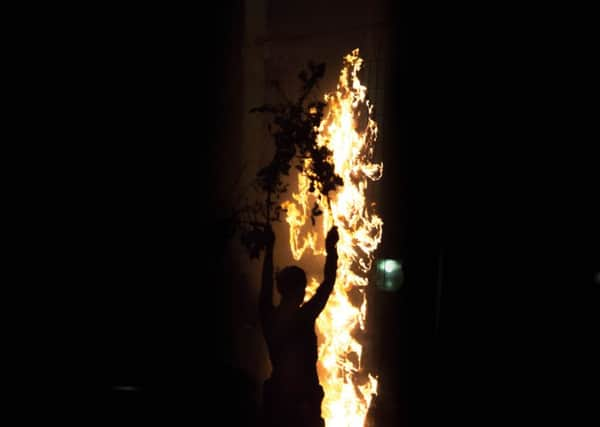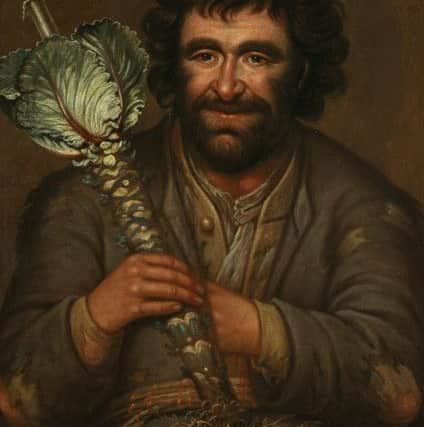9 ancient Halloween customs of Scotland


1.HALLOW FIRES
Halloween, or Samhain, was one of the two great fire festivals of the Celtic calendar and traditionally marked the beginning of the new year.
Hallow fires would be kindled to mark the end of the harvest season and the return of animals to the fold.


Advertisement
Hide AdAdvertisement
Hide AdFires were generally lit on high points of the landscape far from homes and steadings and were seen an attack on the “powers of darkness” at a time of shortenings days and weakened sun, according to McPherson’s Primitive Beliefs in the North East of Scotland.
He added: “In particular, the witches were holding high revelry, and their great conventions to work woe upon mankind were assembled on high hill and bleak moorland.
“Man resorted with cheerful confidence to the heaven-given weapon of holy fire.”
Debris from Hallow fire would be taken to rejuvenate hearths in the home.


Advertisement
Hide AdAdvertisement
Hide AdThe Hallow fire continued to be lit to the end of the 18th Century, according to accounts.
2.TORCHES CIRCLE THE FIELDS
Folk would walk the circuit of their fields with burning torches on Halloween to ward off evil and ensure fertile land for the following year.
The mother and father of the house lit splints from a peat fire before passing them to servants and children of the house. They would then head outdoors and tread the border of the property before throwing the splints to the ground and allowing them to burn out.
3. BURNING WITCHES
With witches feared to be at full power at Halloween, there was only one place for them - the fire.
Advertisement
Hide AdAdvertisement
Hide AdBoys are said to have gone door-to-door asking for a peat to burn the witch.
At Balmoral, when Queen Victoria was in residence, a huge bonfire was set in front of the castle by men dressed in Highland garb, according to McPherson.
Among the men was a trolley - known as a shandy dann - which contained the effigy of a “hideous old woman” who was marched at speed towards the fire to the strain of bagpipes.
Following a sudden stop, a form of charge sheet was read aloud to outline as why the witch should be tipped on the flames.
Advertisement
Hide AdAdvertisement
Hide AdMcPherson wrote: “With a rush an a shout and skirling of bagpipes, the sledge and its occupant are hurled topsy-turvy into the fire.
“Then follow cheers and hoots of derisive laughter as the inflammable wrappings of the shandy dann cracks and sputters out.
“All the while the residents of the castle stand enjoying the curious rite, and no one there entered more heartily into it than the head of the Empire herself.”
4. STONES OF THE SACRED FIRE
In some parts, great attention was paid to the ashes and other debris of the fire.
Advertisement
Hide AdAdvertisement
Hide AdOnce the Hallow fire had burnt out, a stone would be placed on the ash to represent each member of the family.
The next morning, the family would return to the fire to check the stones.
If a stone was missing, the person it represented would be dead before the next Hallow fire was set.
This ritual was recorded in Aberdeenshire and Callander with a version also noted in North Wales.
5. ALE POURED IN TO THE SEA
Advertisement
Hide AdAdvertisement
Hide AdThe Celtic water spirit Shoney was gifted a pot of ale on Halloween to bestow blessings on the local fisherman.
Reports suggest that people on the Isle of Lewis would gather on the beach while one fisherman waded into the water up to his waist before pouring the ale into the sea.
6. PULLING THE CABBAGE STALK
The old rituals acted out on Halloween often had a hint of fortune telling.
Pulling the kail castoc - or cabbage stalk - was noted in a poem by Robert Burns in 1785.
Advertisement
Hide AdAdvertisement
Hide AdTraditionally, a male and female would go blindfolded to the kailyard - or kitchen garden - and pull the first ‘castoc’ that they saw.
It size and shape was said to tell the look of their future spouse. The taste would determine their nature and whether they be sweet or sour. If much earth had stuck to the stalk, the dowry on the bride would be substantial.
The stems would then be placed over the front door. The name of the first person to walk under the kail would be the name of the husband or the wife.
Different versions of the custom exist.
On Islay, kail stocks were also important in the celebration of Halloween. In Islay Voices by Jenni Minto and Les Wilson, one account tells of young men stealing kail and taking the stalks to an old woman skilled in using them to read fortunes.
7.BUNDERING
Advertisement
Hide AdAdvertisement
Hide AdThe kail stalks were sometimes turned into a form of pipe on Halloween for “bundering”.
Boys and young men would go door-to-door with their hollowed out pipes, which would be packed with a type of kindling, and blow smoke into homes to purify them.
8.WIN’ING THE BLEW CLEW
Halloween seemed to be the time to search for answers about a future spouse, McPherson notes.
A woman searching for her husband would tease and spin a ball of wool from a male lamb’s fleece and throw it into the fire on Halloween, holding on to the end of a thread. The woman would take this an start winding another ball.
Advertisement
Hide AdAdvertisement
Hide AdWhen it started to tug , she would ask the fire “Who’s that, that holds the end of my thread?”
The voice from the fire would ‘say’ the name of her husband to be, according to the custom.
In some places, blue yarn had to be thrown into the fire.
9.BURNING NUTS
Each nut would be given the name of a likely suitor before being laid on the fire. How the nuts reacted to the heat would determine the course of the courtship.
McPherson noted that peas were often used in the ritual.
Two were placed on a live peat, one representing a boy and the other a girl. If the two stayed put on the peat as it burned, a happy marriage was signalled.
If one rolled away, it suggested there would be no union.